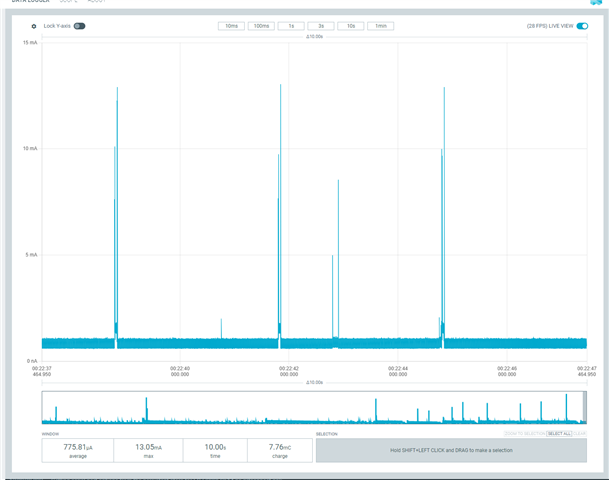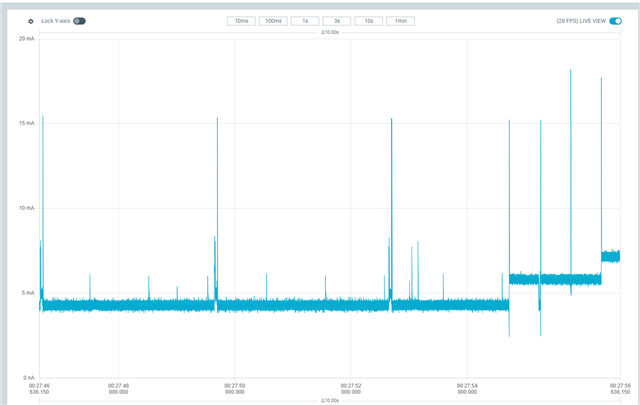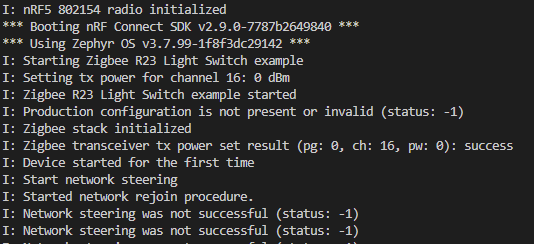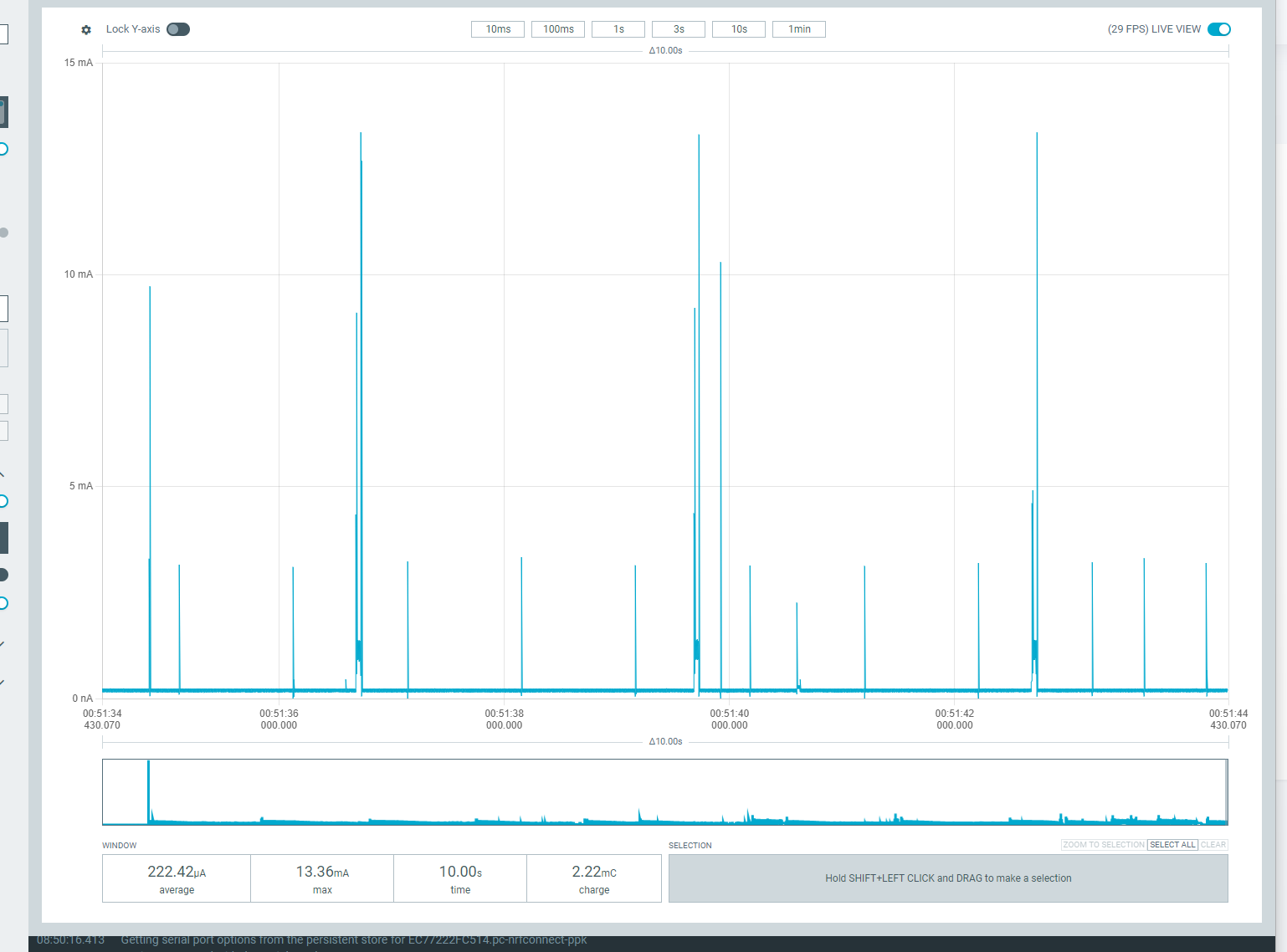Hi,
I´m working on a Zigbee-based environment sensor. You can find all related files here: https://github.com/Kampi/BeeLight
Now I have the following scenario: the whole sensor consumes around 5 mA in idle mode (when going to sleep to wait for a new transmission interval). I´ve started to investigate the issue by using a PPK 2, and I got the following results:
Setup:
- Zigbee2MQTT
- Tx power set to 0
- Device connected to the Zigbee network
Test case 1:
Change main in main.c to:
int main(void)
{
//dk_buttons_init(button_changed);
//dk_leds_init();
//register_factory_reset_button(FACTORY_RESET_BUTTON);
/* Register callback for handling ZCL commands. */
//ZB_ZCL_REGISTER_DEVICE_CB(zcl_device_cb);
/* Register device context (endpoints). */
//ZB_AF_REGISTER_DEVICE_CTX(&env_sensor_ctx);
//clusters_attr_init();
/* Register handler to identify notifications. */
//ZB_AF_SET_IDENTIFY_NOTIFICATION_HANDLER(SENSOR_ENDPOINT, identify_cb);
/* Start Zigbee default thread. */
//zigbee_enable();
//zbus_chan_add_obs(&light_data_chan, &light_data_lis, K_MSEC(100));
//zbus_chan_add_obs(&battery_data_chan, &battery_data_lis, K_MSEC(100));
//zbus_chan_add_obs(&env_data_chan, &env_data_lis, K_MSEC(100));
//LOG_INF("BeeLight application started");
return 0;
}
Goals:
- No I2C transmissions
- No Zigbee enabled
- Periodic wakeup of the processor to read the sensors
- Since no I2C, the sensors can´t be read
- No reports to Zigbee network

I got an average of 780 uA. I can´t say if this is good or bad because I don´t know any reference values.
Test case 2:
Change main in main.c to:
int main(void)
{
//dk_buttons_init(button_changed);
//dk_leds_init();
//register_factory_reset_button(FACTORY_RESET_BUTTON);
/* Register callback for handling ZCL commands. */
//ZB_ZCL_REGISTER_DEVICE_CB(zcl_device_cb);
/* Register device context (endpoints). */
ZB_AF_REGISTER_DEVICE_CTX(&env_sensor_ctx);
clusters_attr_init();
/* Register handler to identify notifications. */
ZB_AF_SET_IDENTIFY_NOTIFICATION_HANDLER(SENSOR_ENDPOINT, identify_cb);
/* Start Zigbee default thread. */
zigbee_enable();
//zbus_chan_add_obs(&light_data_chan, &light_data_lis, K_MSEC(100));
//zbus_chan_add_obs(&battery_data_chan, &battery_data_lis, K_MSEC(100));
//zbus_chan_add_obs(&env_data_chan, &env_data_lis, K_MSEC(100));
//LOG_INF("BeeLight application started");
return 0;
}
Goals:
- No I2C transmissions
- Zigbee enabled
- Periodic wakeup of the processor to read the sensors
- Since no I2C, the sensors can´t be read
- No reports to the Zigbee network

I got an average of 4.2 to 4.8 mA, so enabling Zigbee increases the current consumption by a factor of 6?!
Questions:
- Do you have some values as a reference to compare with?
- Do I have any additional power-saving options?
- How can I cut down the current consumption?
Edit:
I´ve tried to run the light switch example on my board (I built the example for the nRF54L15DK), but the firmware stops booting after printing this
00> [00:00:00.000,356] <inf> ieee802154_nrf5: nRF5 802154 radio initialized
Flashing my firmware results in a correct boot:
00> [00:00:21.228,014] <inf> ieee802154_nrf5: nRF5 802154 radio initialized 00> *** Booting My Application v1.0.0-2cd7fb859a2a *** 00> *** Using nRF Connect SDK v2.9.2-4ab7b98fc76f *** 00> *** Using Zephyr OS v3.7.99-aa34a5632971 ***
I´m not sure about the issue, so I can´t test a sample as a reference. Do you have an idea why Zephyr isn´t booted with the light switch example?


